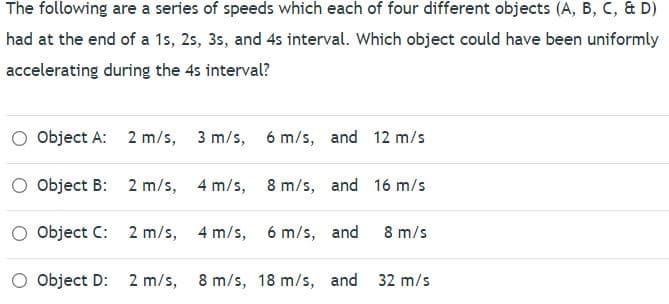The following are a series of speeds which each of four different objects (A, B, C, & D) had at the end of a 1s, 2s, 3s, and 4s interval. Which object could have been uniformly accelerating during the 4s interval? Object A: 2 m/s, 3 m/s, 6 m/s, and 12 m/s Object B: 2 m/s, 4 m/s, 8 m/s, and 16 m/s Object C: 2 m/s, 4 m/s, 6 m/s, and 8 m/s Object D: 2 m/s, 8 m/s, 18 m/s, and 32 m/s
The following are a series of speeds which each of four different objects (A, B, C, & D) had at the end of a 1s, 2s, 3s, and 4s interval. Which object could have been uniformly accelerating during the 4s interval? Object A: 2 m/s, 3 m/s, 6 m/s, and 12 m/s Object B: 2 m/s, 4 m/s, 8 m/s, and 16 m/s Object C: 2 m/s, 4 m/s, 6 m/s, and 8 m/s Object D: 2 m/s, 8 m/s, 18 m/s, and 32 m/s
Related questions
Question
6

Transcribed Image Text:The following are a series of speeds which each of four different objects (A, B, C, & D)
had at the end of a 1s, 2s, 3s, and 4s interval. Which object could have been uniformly
accelerating during the 4s interval?
Object A: 2 m/s, 3 m/s,
6 m/s, and 12 m/s
Object B: 2 m/s, 4 m/s,
8 m/s, and 16 m/s
Object C: 2 m/s, 4 m/s,
6 m/s, and
8 m/s
Object D:
2 m/s, 8 m/s, 18 m/s, and 32 m/s
Expert Solution
This question has been solved!
Explore an expertly crafted, step-by-step solution for a thorough understanding of key concepts.
Step by step
Solved in 2 steps with 1 images
